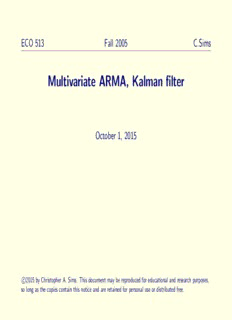
Notes: ARMA models PDF
Preview Notes: ARMA models
ECO 513 Fall 2005 C.Sims Multivariate ARMA, Kalman filter October 1, 2015 (cid:13)c 2015 by Christopher A. Sims. This document may be reproduced for educational and research purposes, so long as the copies contain this notice and are retained for personal use or distributed free. The finite MA class of models k (cid:88) y = a ε = a(L)ε . t s t−s t s=0 y may be m × 1, in which case a is m × m. ε ∼ N(0, Σ), i.i.d. Or s sometimes just mean 0, variance Σ, not serially correlated. Properties: • Dense in the space of LR stationary processes. • Closed under taking linear combinations. • Closed under taking subvectors. 1 • To keep uniqueness, must restrict parameter space to fundamental MA’s. This restriction (on roots) is quite nonlinear. But the fundamental MA’s form a closed set with open interior, since roots are continuous functions of parameters. 2 Is the set of fundamental MA operators convex? This is an important point, since if it is convex, then iterative methods for maximizing likelihood subject to the constraint are likely to work well, because concave functions over a convex set have a unique maximum, while with a non-convex constraint set there can be multiple boundary maxima, even for concave functions. For second-order operators, the set is convex. There is a famous diagram showing the set of values of ρ and ρ for which the roots of 1 + ρ z + ρ z2 1 2 1 2 all lie on or outside the unit circle, shown in Figure 1. 3 2 1 ) 1 − 1, 1, 0 1, − ( c 1 − 2 − −2 −1 0 1 2 c(0, 2, −2, 0) Figure 1: ρ , ρ values yielding invertible 1 + ρ L + ρ L2 1 2 1 2 4 This is obviously a convex region. However, beyond two dimensions the region is no longer convex. For example, consider P(L) = 1 − 3L + 3L2 − L3 and Q(L) = 1 + L. The first has three roots, all 1. The second has one root of -1. An equal weighted linear combination of the two, 1 − L + 1.5L2 − .5L3 has a pair of complex roots with absolute value .89, and one real root of 2.5. So the region is not convex for third order polynomials. 5 The finite AR class of models k (cid:88) y = b y + ε , or b(L)y = ε . t s t−s t t t s=1 ε ∼ N(0, Σ), or sometimes just mean 0, variance Σ, not correlated with past y’s, and therefore not serially correlated. Properties: • Dense in the space of LR stationary processes, plus includes some types of non-stationary processes • Not closed under taking linear combinations 6 • Not closed under taking subvectors. • No uniqueness problem. Every set of real numbers used to populate b , s s = 1, . . . , k results in a distinct model. Restrictions like that to obtain fundamental MA’s if we want to consider only stationary models. But this restriction is not needed to prevent redundancy. 7 Finite-order ARMA models B(L)y = A(L)ε , t t where ε ⊥ {y , s < t} (and ε is therefore the innovation in y at t) and t s t B and A are finite-order polynomials in L, perhaps with matrix-valued coefficients. Properties: • Contains MA and AR models, so is also dense in the LR class of models. • Closed under taking linear combinations. • Like the finite-order AR class, contains non-stationary as well as stationary models. 8 • Has the same problems as the MA class with possible redundancy in the A(L) parameter space. • Has the same problem as the AR class with the restrictions on B(L) needed if we want to restrict to stationary models. • Has its own special, severe problem of non-uniqueness, because of possible cancellation between AR and MA roots. 9
Description: